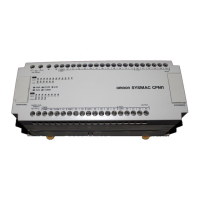329
Special Instructions Section 5-26
Description FCS(––) can be used to check for errors when transferring data through com-
munications ports.
When the execution condition is OFF, FCS(––) is not executed. When the exe-
cution condition is ON, FCS(––) calculates the frame checksum of the speci-
fied range by exclusively ORing either the contents of words R
1
to R
1
+N–1 or
the bytes in words R
1
to R
1
+N–1. The frame checksum value (hexadecimal) is
then converted to ASCII and output to the destination words (D and D+1).
The function of bits in C are shown in the following diagram and explained in
more detail below.
Number of Items in Range The number of items within the range (N) is contained in the 3 rightmost digits
of C, which must be BCD between 001 and 999.
Calculation Units The frame checksum of words will be calculated if bit 13 is OFF and the frame
checksum of bytes will be calculated if bit 13 is ON.
If bytes are specified, the range can begin with the leftmost or rightmost byte
of R
1
. The leftmost byte of R
1
will not be included if bit 12 is ON.
When bit 12 is OFF the bytes will be ORed in this order: 1, 2, 3, 4, ....
When bit 12 is ON the bytes will be ORed in this order: 2, 3, 4, 5, ....
Conversion to ASCII The byte frame checksum calculation yields a 2-digit hexadecimal value which
is converted to its 4-digit ASCII equivalent. The word frame checksum calcula-
tion yields a 4-digit hexadecimal value which is converted to its 8-digit ASCII
equivalent, as shown below.
Flags ER: Indirectly addressed DM word is non-existent. (Content of *DM word
is not BCD, or the DM area boundary has been exceeded.)
The number of items is not 001 to 999 BCD.
15 14 13 12 11 00
Number of items in range (N, BCD)
001 to 999 words or bytes
First byte (when bit 13 is ON)
1 (ON): Rightmost
0 (OFF): Leftmost
Calculation units
1 (ON): Bytes
0

